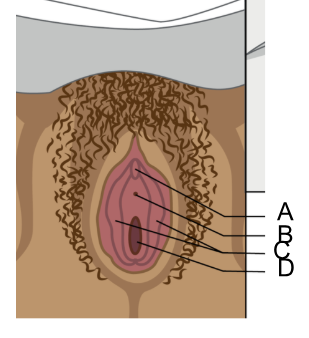The nurse observes the external genitalia of a female client in preparation for inserting an indwelling urinary catheter. At which location should the catheter be inserted? (Mark location on image)

A
B
C
D
The Correct Answer is B
A. Clitoris: This is a highly sensitive erectile tissue and not connected to the urinary system.
B. Urethra: This is the correct site for catheter insertion, as it leads directly into the urinary bladder.
C. Labia: These are external folds of skin that surround the urethral and vaginal openings, not the site for catheter insertion.
D. Vagina: Inserting a catheter here would result in incorrect placement. The vagina is posterior to the urethra.
Nursing Test Bank
Naxlex Comprehensive Predictor Exams
Related Questions
Correct Answer is A
Explanation
A. "Risk for self-directed violence as evidenced by feelings of hopelessness": The client’s feelings of hopelessness, combined with significant weight loss and loss of interest in activities, suggest possible depression. Hopelessness is a key symptom of depression, which can increase the risk for self-harm or suicide.
B. "Chronic low self-esteem as evidenced by feelings of worthlessness": Feelings of worthlessness are part of the larger picture of the client’s depression. The priority is to address the immediate risk of harm, which takes precedence over chronic low self-esteem.
C. "Anxiety as evidenced by abdominal discomfort secondary to depression": While abdominal discomfort can be a symptom of depression, it is secondary to the more immediate concern of the client’s potential risk for self-directed violence.
D. "Imbalanced nutrition as evidenced by 25 lb (11 kg) weight loss in four months": The significant weight loss is concerning, but it is likely a result of the client’s depression. The focus should first be on addressing the client’s safety, followed by nutrition and weight restoration.
Correct Answer is ["0.6"]
Explanation
Rationale:
- Convert the client's weight from pounds (lb) to kilograms (kg).
Weight in kg = 154 lb / 2.2 lb/kg
= 70 kg.
- Calculate the total desired dose in units.
Desired dose (units) = Desired dose (units/kg) × Weight (kg)
= 200 units/kg × 70 kg
= 14000 units.
Available concentration of the medication = 25,000 units/mL.
- Calculate the volume in milliliters (mL) to administer.
Volume (mL) = Desired dose (units) / Available concentration (units/mL)
= 14000 units / 25000 units/mL
= 0.56 mL.
- Round the answer to the nearest tenth.
= 0.6.
Whether you are a student looking to ace your exams or a practicing nurse seeking to enhance your expertise , our nursing education contents will empower you with the confidence and competence to make a difference in the lives of patients and become a respected leader in the healthcare field.
Visit Naxlex, invest in your future and unlock endless possibilities with our unparalleled nursing education contents today
Report Wrong Answer on the Current Question
Do you disagree with the answer? If yes, what is your expected answer? Explain.
Kindly be descriptive with the issue you are facing.
